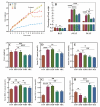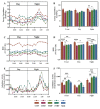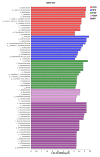Anti-Obesity Effects of Dietary Fibers Extracted from Flaxseed Cake in Diet-Induced Obese Mice
- PMID: 37049557
- PMCID: PMC10097256
- DOI: 10.3390/nu15071718
Anti-Obesity Effects of Dietary Fibers Extracted from Flaxseed Cake in Diet-Induced Obese Mice
Abstract
Although many efforts have been made to characterize the functional properties of flaxseed, knowledge concerning the properties of insoluble and soluble dietary fibers in flaxseed is still limited. Here, insoluble and soluble dietary fibers were extracted from flaxseed cake-a valuable resource that has not been fully exploited. Subsequently, their monosaccharide compositions, structural properties, and anti-obesity effects in male mice were characterized. The anti-obesity effects of flaxseed cake insoluble dietary fiber (FIDF), flaxseed cake soluble dietary fiber (FSDF), and FIDF combined with FSDF in diet-induced obese mice were investigated in our study. Supplementation with FSDF alone or FIDF and FSDF together lowered the fat accumulation, improved the serum lipid profile, increased the basal metabolism, and improved the gut microbiota of obese mice. Supplementation with FIDF and FSDF together significantly enriched the abundance of g_Akkermansia and g_Bifidobacterium, which are negatively associated with obesity. Supplementation with FIDF alone improved the liver lipid profile, raised the basal metabolism, and enhanced the short-chain fatty acid levels in the guts of the mice. In conclusion, our results collectively support the therapeutic potential of FIDF and FSDF in obesity treatment and indicate that FIDF and FSDF play different roles in the process of obesity treatment. Furthermore, our results provide critical information for flaxseed cake resource exploitation.
Keywords: flaxseed cake; gut microbiota; high-fat diet; insoluble dietary fiber; lipid accumulation; soluble dietary fiber.
Conflict of interest statement
The authors declare no conflict of interest.
Figures







Similar articles
-
Microbial fermentation of flaxseed fibers modulates the transcriptome of GPR41-expressing enteroendocrine cells and protects mice against diet-induced obesity.Am J Physiol Endocrinol Metab. 2019 Mar 1;316(3):E453-E463. doi: 10.1152/ajpendo.00391.2018. Epub 2018 Dec 18. Am J Physiol Endocrinol Metab. 2019. PMID: 30562060
-
Effects of Dietary Fiber Supplementation on Fatty Acid Metabolism and Intestinal Microbiota Diversity in C57BL/6J Mice Fed with a High-Fat Diet.J Agric Food Chem. 2018 Dec 5;66(48):12706-12718. doi: 10.1021/acs.jafc.8b05036. Epub 2018 Nov 20. J Agric Food Chem. 2018. PMID: 30411889
-
Simultaneous Intake of Euglena gracilis and Vegetables Exerts Synergistic Anti-Obesity and Anti-Inflammatory Effects by Modulating the Gut Microbiota in Diet-Induced Obese Mice.Nutrients. 2019 Jan 21;11(1):204. doi: 10.3390/nu11010204. Nutrients. 2019. PMID: 30669573 Free PMC article.
-
[Nutritional value and functional properties of flaxseed].Vopr Pitan. 2012;81(3):4-10. Vopr Pitan. 2012. PMID: 22888664 Review. Russian.
-
Physiological and Pathological Considerations for the Use of Flaxseed as a Therapeutic Dietary Strategy.Rev Cardiovasc Med. 2023 May 18;24(5):149. doi: 10.31083/j.rcm2405149. eCollection 2023 May. Rev Cardiovasc Med. 2023. PMID: 39076734 Free PMC article. Review.
Cited by
-
Naringin ameliorates obesity via stimulating adipose thermogenesis and browning, and modulating gut microbiota in diet-induced obese mice.Curr Res Food Sci. 2024 Jan 18;8:100683. doi: 10.1016/j.crfs.2024.100683. eCollection 2024. Curr Res Food Sci. 2024. PMID: 38313225 Free PMC article.
-
Gut microbiota involvement in the effect of water-soluble dietary fiber on fatty liver and fibrosis.Biosci Microbiota Food Health. 2025;44(1):49-57. doi: 10.12938/bmfh.2024-046. Epub 2024 Aug 21. Biosci Microbiota Food Health. 2025. PMID: 39764489 Free PMC article.
-
Targeting the Gut Microbiome to Treat Cardiometabolic Disease.Curr Atheroscler Rep. 2024 Feb;26(2):25-34. doi: 10.1007/s11883-023-01183-2. Epub 2024 Jan 5. Curr Atheroscler Rep. 2024. PMID: 38180642 Review.
-
Characterization and Function Analysis of Soluble Dietary Fiber Obtained from Radish Pomace by Different Extraction Methods.Molecules. 2024 Jan 19;29(2):500. doi: 10.3390/molecules29020500. Molecules. 2024. PMID: 38276578 Free PMC article.
-
The Impact of Flaxseed (Linum usitatissimum L.) Oil Supplementation on Human Health: A Human-Centric Evidence-Graded Approach.Nutrients. 2025 May 25;17(11):1791. doi: 10.3390/nu17111791. Nutrients. 2025. PMID: 40507062 Free PMC article. Review.
References
-
- Choi B.S., Daniel N., Houde V.P., Ouellette A., Marcotte B., Varin T.V., Vors C., Feutry P., Ilkayeva O., Stahlman M., et al. Feeding diversified protein sources exacerbates hepatic insulin resistance via increased gut microbial branched-chain fatty acids and mTORC1 signaling in obese mice. Nat. Commun. 2021;12:3377. doi: 10.1038/s41467-021-23782-w. - DOI - PMC - PubMed
-
- Jovanovski E., Mazhar N., Komishon A., Khayyat R., Li D., Blanco Mejia S., Khan T., Jenkins A.L., Smircic-Duvnjak L., Sievenpiper J.L., et al. Effect of viscous fiber supplementation on obesity indicators in individuals consuming calorie-restricted diets: A systematic review and meta-analysis of randomized controlled trials. Eur. J. Nutr. 2021;60:101–112. doi: 10.1007/s00394-020-02224-1. - DOI - PubMed
MeSH terms
Substances
Grants and funding
LinkOut - more resources
Full Text Sources
Medical

